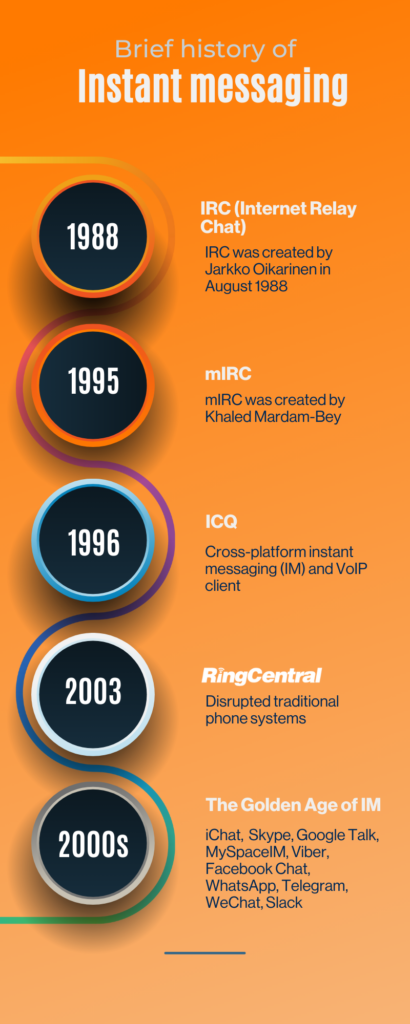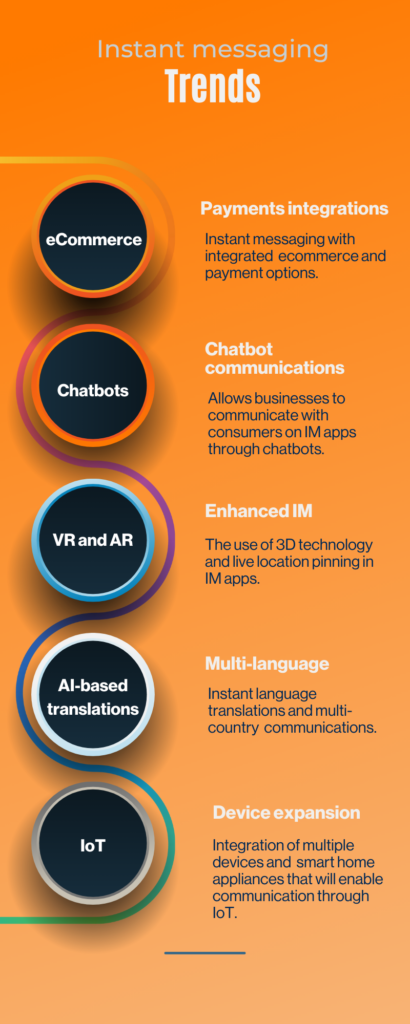What is instant messaging?
Instant messaging (IM) empowers businesses to communicate efficiently, collaborate effectively, and enhance customer experiences. Instant messaging (IM) has transformed the way businesses communicate, both internally and externally. Its real-time, asynchronous nature, coupled with its accessibility, has made it an indispensable tool for modern organisations.
The crucial role of instant messaging (IM) for businesses:
Real-time communication
- IM platforms enable instant, synchronous communication among team members, clients, and partners.
- Quick responses lead to faster decision-making, issue resolution, and project progress.
Efficient collaboration
- Instant messaging tools integrate seamlessly with other business apps (e.g., project management, CRM, file sharing).
- Teams can discuss tasks, share files, and collaborate on projects within a single interface.
Remote work and flexibility
- Instant messaging (IM) bridges geographical gaps, allowing remote teams to stay connected.
- Service providers can offer support, answer queries, and address issues from anywhere.
Customer service and support
- Instant messaging (IM) for business enhances customer interactions by providing real-time assistance.
- Service providers can resolve inquiries promptly, improving customer satisfaction.
Security and compliance
- Modern IM platforms prioritize security (end-to-end encryption, access controls).
- Compliance features ensure adherence to industry regulations (e.g., GDPR, HIPAA, Data Protection Act).
Reduced email overload
- IM reduces reliance on lengthy emails, streamlining communication.
- Service providers can focus on critical messages without drowning in inbox clutter.
In the late 1980s instant messaging (IM) emerged as a revolutionary concept, allowing people worldwide to connect in real-time.
mIRC: Developed in 1988, mIRC was one of the earliest IM platforms. It allowed users to chat in real-time using client software.
ICQ launched in 1996 by Mirabilis, ICQ enabled one-on-one or group chats, file exchanges, and user searches.
The late 1990s saw fierce competition among major IM platforms such as:
AOL Instant Messenger (AIM) pioneered the “Buddy List” concept and dominated the North American market.
MSN Messenger (later Windows Live Messenger) gained popularity, with approximately 2.5 billion daily messages sent by 2005.
Yahoo! Messenger allowed users with Yahoo IDs to connect and communicate, also boasting some of the most colourful emoticons and also a BUZZ!!!, e feature used to get the attention of another user
The Golden Age of Instant Messaging (IM) in the 2000s was a transformative period marked by significant advancements in communication technology. The 2000s laid the foundation for modern communication tools, influencing the development of current messaging apps and social media platforms. It was a period of rapid innovation that transformed how people connected and communicated.
Photo sharing: Platforms allowed users to share photos.
Video calls: Video chat became common, transforming business communication and personal connections.
Games and more: IM platforms integrated games and other features.
IM has come a long way from basic text-based communication. It now encompasses rich features like multimedia sharing, real-time collaboration, and integrations with other tools. As businesses adapt to changing work environments, IM plays a pivotal role in enhancing productivity and connectivity.
- Productivity Boost:
- IM enables swift communication, reducing delays associated with emails.
- Teams can share files, discuss projects, and make decisions in real time.
- Chatbots automate routine tasks, freeing up human resources for more strategic work.
- Enhanced Connectivity:
- IM bridges geographical gaps, connecting remote teams seamlessly.
- Video calls, screen sharing, and virtual meetings foster deeper connections.
- Integrations with project management tools streamline workflows.
- User Experiences:
- IM platforms prioritize user-friendly interfaces and intuitive designs.
- Features like instant translations, VR/AR, and payment integrations enhance user experiences.
- Personalization options allow users to tailor their IM environment.
Trends in instant messaging (IM) for business communications
In recent years, instant messaging (IM) has revolutionized business communications, becoming a cornerstone of modern workplace interactions. The shift towards remote and hybrid work models has accelerated the adoption of IM platforms. These tools offer real-time communication, fostering collaboration and efficiency. Key trends include the integration of AI for automated responses, enhanced security features to protect sensitive information, and the rise of unified communication platforms that combine messaging, video conferencing, and file sharing. As businesses continue to evolve, IM remains a vital tool for seamless and effective communication.
- Payment Integrations:
- IM platforms are integrating payment features, allowing users to make transactions seamlessly within chats.
- Businesses can collect payments, send invoices, and handle financial interactions directly through IM apps.
2. Chatbots:
- AI-powered chatbots enhance customer service by providing instant responses and handling routine queries.
- They streamline communication, improve efficiency, and offer 24/7 support.
- Enhanced IM with VR and AR:
- Virtual Reality (VR) and Augmented Reality (AR) are transforming IM experiences.
- Imagine collaborating on a 3D model or conducting virtual meetings within an immersive environment.
- Instant Translations:
- IM platforms now offer real-time language translation.
- Businesses can communicate globally without language barriers, fostering international collaboration.
5. Device Expansion to IoT:
- IM is expanding beyond traditional devices (phones, laptops) to Internet of Things (IoT) devices.
- Imagine sending messages to smart appliances, wearables, or connected vehicles.
Business communication has evolved remarkably, transitioning from simple text-based chats to sophisticated, multifaceted platforms. Today’s tools, such as RingCentral RingEX, Slack and Microsoft Teams, integrate messaging, video conferencing, and file sharing, creating seamless communication ecosystems.
The rise of artificial intelligence and machine learning is further enhancing these platforms with features like automated responses and predictive text. Enhanced security measures ensure the protection of sensitive information, fostering trust and reliability. As remote and hybrid work models become the norm, these innovations are crucial for maintaining productivity and collaboration.
Looking ahead, we can anticipate even more groundbreaking solutions that will continue to transform how businesses connect and collaborate, driving efficiency and innovation in the workplace.
Originally published Aug 12, 2024



